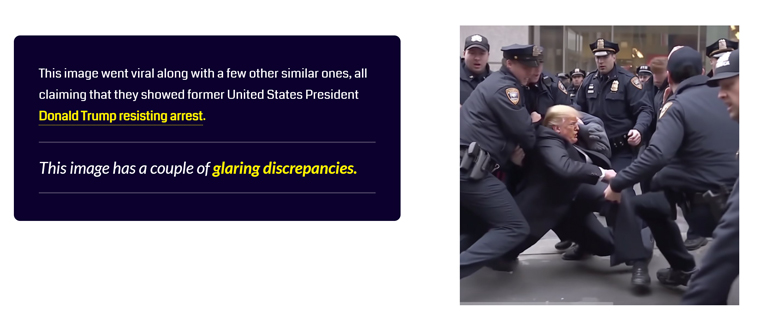The Quint creates a cheat sheet to identify AI-generated images
Ideas Blog | 27 May 2024
With generative AI tools now available to the public at no or negligible cost, different social media platforms have witnessed an unprecedented number of AI-generated images.
Our team saw not only Internet users but several media organisations around the world fell for these images. Some photos showed the Pope in a white Balenciaga puffer jacket and former U.S. President Donald Trump being “arrested” on the street.

While these specific AI-generated images had less impact, one such photo that showed an explosion at the U.S. Pentagon demonstrated how these artificial images can have huge real-life implications: The photo of the blast, which was not real, caused a slight dip in the U.S. stock markets.
To tackle this prevalent issue, our team at The Quint decided to develop and design a project that would act as a guide to help people escape the menace of generative AI images. Aiming to make it as easy to consume as possible, we adopted an immersive format to ensure we could explain the process with plenty of visual examples, which helped us drive the point home.
Keeping it simple
Our project was developed keeping simplicity and user-friendliness in mind. We used examples of several popular AI images and demonstrated the various anomalies that one can look for to distinguish between AI and human-generated images.

We also mentioned tools that fact-checkers usually use when dealing with such images. The Quint explained reverse image search in detail and highlighted the importance of depending on credible news reports.
Our team also included a quiz that made the story more interactive and allowed readers to test their learnings. The quiz used AI and human-generated images and asked readers to identify the same.
We did this so our readers could quickly figure out whether they could grasp what was explained in the article and go back and revisit the part of the immersive story to ensure they got the hang of it.
Extending the campaign’s reach
We received positive feedback on this campaign. One of our readers appreciated our efforts to address the vacuum experienced while dealing with media literacy. The interactive received over 5,000 views and was one of the resources featured in the Citizen Digital Foundation’s media literacy course, Litt.
The immersive project also found its way into some of our media literacy workshops, proving itself the most simple and engaging way to help people understand the basics of spotting images made by generative AI tools. It has also acted as a springboard for our subsequent fact-checks, where we debunk AI-generated content or deepfakes.
































